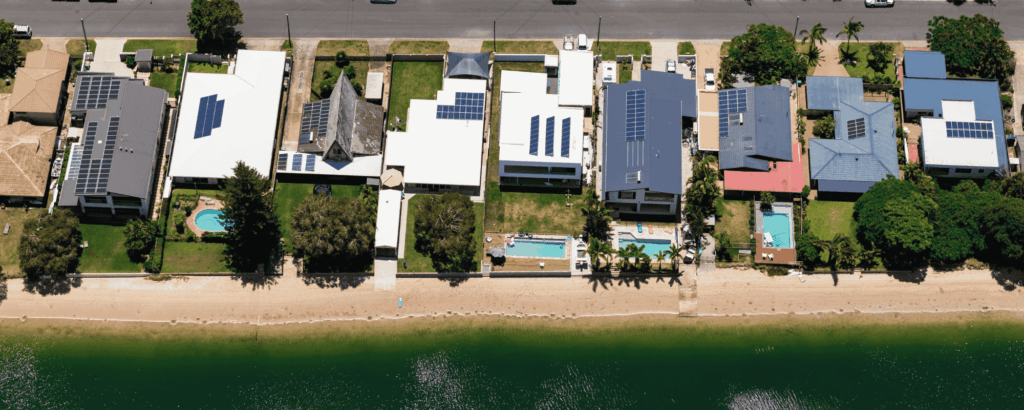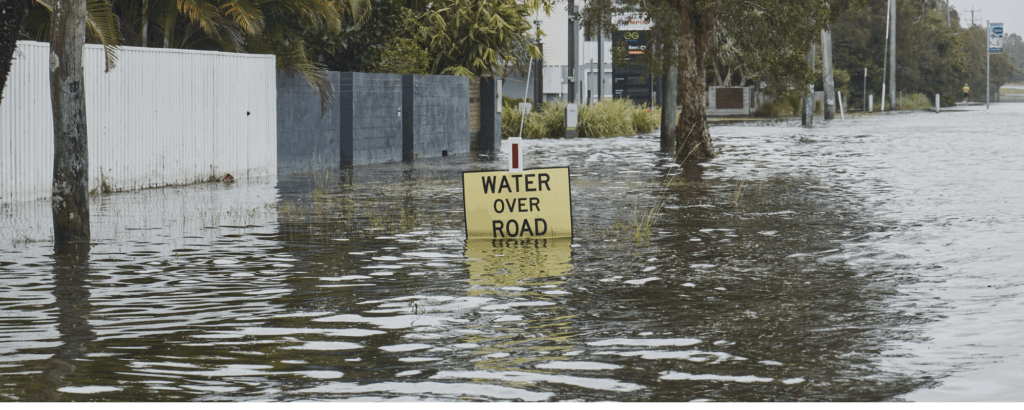Australia is the world leader in rooftop solar, with solar now on more than 4 million roofs – that’s one in three households! As we generate more and more power with rooftop solar, storing the excess electricity becomes increasingly important. Home batteries allow households and businesses the flexibility of soaking up energy from the sun, storing it and using it whenever they need.
Installing a battery helps families and businesses slash their power bills by reducing reliance on grid power during the evening, when electricity prices are more expensive. Pairing a battery with rooftop solar almost doubles a household’s savings: up to $2300 less per year on power bills for the average family, compared to $1500 in savings with solar only.
There is enormous potential to roll out more home batteries across Australia, with 8 per cent of the four million households with solar currently storing their excess solar power with a battery. The Climate Council’s analysis shows that with additional policies, we can add two million batteries to households and businesses by 2030. If we do so, that could collectively save Australians more than $4 billion on their power bills each year.
With so much information out there about this exciting, relatively new technology, it can be hard to figure out the facts from the fiction when it comes to the risks and benefits of batteries. We’re here to help, with answers to eight common questions about home batteries.
Are you interested in installing a home battery but don’t know where to start? We’ve pulled together some key considerations, support and resources to help you on your way to charging your home with a battery.
How much do home batteries cost?
There are now around 80 different home batteries available in Australia, starting at around $4000 for a smaller, 5kWh battery. For a typical Australian home, a battery costs between $10,000 to $13,000. The costs of batteries are falling as technology and economies of scale improve. The price of lithium has also dropped, helping reduce production costs.
As prices drop, the time it takes for a battery to pay for itself through power bill savings is also falling. While the payback period depends on a lot of factors, in 2024, the average payback period on a home battery in Australia was around 8.3 years, compared to 10 years in 2022 and 19 years in 2016. With the average Australian staying in their home for around nine years, this means batteries are now in reach for more Australians than ever. Government support can make a big difference in tipping the scales: the Australian Government’s Cheaper Home Batteries Program will reduce the cost of a home battery by around 30 per cent, reducing the payback period significantly.
Increased demand for batteries as a result of subsidies, including the Cheaper Home Batteries Program, could also help prices fall further. Through the Cheaper Home Batteries program, discounts on home batteries are being provided through the Small-scale Renewable Energy Scheme (SRES). Since rooftop solar was included in the SRES in 2012, the cost has more than halved.
Although batteries are becoming more affordable for more Australians, renters, apartment dwellers and people on low or fixed incomes still face many barriers in installing their own solar and batteries. Community-scale batteries are one key way of sharing the benefits of cheaper, clean solar power with households that face barriers to installing their own solar and batteries. Governments should also deliver programs to install solar and batteries in social housing stock, and consider mechanisms to encourage rental property owners to install solar and batteries.
What are virtual power plants (VPPs)?
Government incentives for installing a home battery are increasingly requiring participation, or capacity to participate in, a virtual power plant (VPP). A VPP connects individual batteries on homes and businesses so they can act as one single, large power plant. By joining a VPP, households with solar and batteries can access financial benefits by selling their stored solar power to the grid in peak times when prices are high, while sharing their clean energy with the community.
VPPs boost the benefits of home batteries to the grid significantly, as they enable network operators to more accurately manage energy generation, storage and use. When combined, the relatively small amount of power stored in each battery adds up to a large amount that can be used to help balance out supply and demand on the local grid. Effective coordination of batteries on homes and businesses could offset the need for an additional $4.1 billion in grid-scale storage investment – putting downward pressure on everyone’s bills, not just those with batteries.
There are a range of VPP offerings available across Australia, and it’s important to make an informed decision about participating in a VPP, for example by comparing offers from multiple providers. Each provider offers different conditions, such as the price you receive for your excess power, when the VPP can access your battery, and how much of your power can be exported to the grid. Governments and energy bodies have an important role to play in ensuring consumers have access to the information they need to make informed decisions about participating in a VPP.
Are home batteries safe?
As Australians have been embracing EVs, e-bikes, -e-scooters and even battery-powered appliances like vacuum cleaners, there have been increasing reports in the media around battery fires. While these fires can be dangerous when they do occur, they are not as common as media reports can make it seem. For example, data from around the world shows that EV fires are actually around 20 times less likely than fires in petrol and diesel cars. In Australia, there have only been eight reported EV battery fires since 2021.
Home batteries are tightly regulated in Australia. The Clean Energy Council maintains a list of approved home batteries that meet industry best practice requirements. Batteries must be installed by a licensed electrician. Through the Australian Government’s Cheaper Home Batteries Program, installations will be audited through the Clean Energy Regulator’s ongoing inspection program to monitor safe installation practices.
However, some battery products, in particular items like e-bikes and e-scooters, are currently less tightly regulated than EVs, household batteries and big batteries. This means there are cheap, poorer quality products in the market that come with higher risks. State and territory electrical safety regulators are responsible for regulating electrical consumer products. As part of the National Battery Strategy, the Australian Government has committed to work with states and territories to standardise regulation across the country. Australia’s Environment Ministers are working on a proposal, led by NSW and Victoria, to ensure batteries are safely managed throughout their lifecycle. In early 2025, the NSW Government became the first Australian state to have battery stewardship laws.
Where are batteries made?
Most batteries currently come from China, the US and the EU. Some other countries including Canada, the UK and South Korea also make batteries. While Australia is the world’s top producer of lithium, the key component in most home batteries, we don’t yet have an established battery manufacturing industry. However, the Australian Government is supporting Australia’s manufacturing capabilities to grow through the National Battery Strategy, including the $523 million Battery Breakthrough Initiative.
Energy Renaissance in NSW, which focuses on commercial and industrial batteries, is Australia’s first lithium-ion battery manufacturer.
What is the environmental impact of home batteries?
Critical minerals like lithium are essential to our shift to a renewable power system, but just like all mining, the extraction of these resources comes with environmental impacts. There is a large body of evidence showing that the benefits of clean energy technologies far outweigh the climate pollution along supply chains. For example, total lifecycle greenhouse gas emissions of EVs are around half those of internal combustion engine cars on average, with the potential for a further 25 per cent reduction when powered by renewable energy.
Research also shows that a renewable power system will require significantly less mining than the current fossil system. Currently, about 1500 million tonnes of fossil fuels are mined and extracted each year. The International Energy Agency projects that by 2040, we could be extracting around 28 million tonnes of critical minerals around the world for renewable energy – more than 500 times less mining than under the current fossil fuel system!
Unlike fossil fuels, which cannot be re-used after they are combusted to make electricity, and must be extracted on an ongoing basis, minerals and metals in batteries can be reused and recycled continuously: currently, around 95 per cent of the materials in lithium-ion batteries can be recycled. However, we only recycle 10 per cent of lithium-ion batteries. This means the majority of battery waste is either stockpiled or goes to landfill – creating significant environmental and health risks, including fire risk.
We can reduce the environmental impacts of the shift to renewable power by recycling batteries as much as we can. We currently recycle 98 per cent of our lead acid batteries, demonstrating what is possible with the right systems in place. There is already work underway: last year, CSIRO opened an Australian-first pilot facility for a domestic solution to the safe treatment, recycling and disposal of used lithium-ion batteries. In New South Wales, the EPA has partnered with local councils to establish a trial to accept products with embedded batteries at select Community Recycling Centre locations.
How are batteries made?
Critical minerals in batteries including lithium, cobalt and nickel, have historically been sourced from some regions where there are credible complaints of human rights abuses and low environmental standards. However, strong environmental, social and governance (ESG) practices along supply chains are increasingly becoming essential for companies to access battery markets around the world.
To ensure batteries and other low emissions technologies are made in ways that reduce environmental impacts and promote human rights, the international community, led by Canada, has established the Sustainable Critical Minerals Alliance. Australia is a foundational member of the Alliance, together with the United Kingdom, France, Germany and the United States. The Alliance commits its members to developing sustainable and inclusive mining practices, and sourcing critical minerals that:
- protect the environment
- support local and Indigenous communities
- help fight climate change
- restore ecosystems
- build a circular economy
- foster ethical corporate practices.
As Australia works to develop our own battery industry, we must build an industry that meets the highest possible standards of environmental performance and engagement with landholders, including through gaining the free, prior and informed consent of local First Nations groups.
Can I use the battery in my electric car as a home battery?
Electric vehicles (EVs) contain powerful batteries: up to ten times more powerful than a typical home battery. Vehicle-to-grid (V2G) is an emerging technology that enables an EV to not only charge using power from the grid, but to supply stored power back to the home or the grid. A household with rooftop solar can store excess solar power in their car battery and then use this power when they need, or sell it back to the grid, providing a source of income. Early adopters of V2G are making around $1000 every year from selling energy back into the grid from their cars. On top of this, switching to an EV can save households around $2000 every year on petrol or diesel costs.
V2G is still an emerging technology and currently only works in a limited number of cars and chargers. However, it is set to become available to more and more Australians in the near future. In late 2024, Australia adopted a national standard for V2G which will enable V2G chargers to be approved for use in Australia, in turn encouraging more manufacturers to enter the Australian market. South Australia is leading the way: SA Power Networks has announced that it will treat V2G charging in the same way it does a typical home battery, and has launched a new website explaining what keen EV buyers need to do to hook their car into the grid. These are important steps in enabling the adoption of the technology – but more coordinated, national action is needed.
Want to know more about how batteries are helping Australia unlock its renewable potential? See our report Battery Boom: Supercharging Australia’s Renewable Rollout











